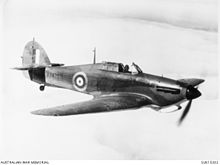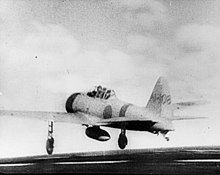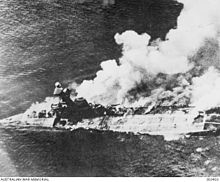Easter Sunday Raid
This article needs additional citations for verification. (April 2015) |
| Easter Sunday Raid on Ceylon | |||||||
|---|---|---|---|---|---|---|---|
| Part of the Pacific Theatre of World War II | |||||||
 British heavy cruisers HMS Dorsetshire and Cornwall under Japanese air attack and heavily damaged off the southwest of Ceylon, on Easter Sunday, 5 April 1942 | |||||||
| |||||||
| Belligerents | |||||||
|
| |||||||
| Casualties and losses | |||||||
| 7 aircraft[1] |
27 aircraft | ||||||
The Easter Sunday Raid (or Battle of Ceylon) was an air attack by carrier-based aircraft of the Imperial Japanese Navy against Colombo, Ceylon (now Sri Lanka), on Easter Sunday, 5 April 1942, during the South-East Asian theatre of World War II. This attack was part of the Indian Ocean Raid, and was followed a few days later by a similar attack on Trincomalee. The targets were British warships, harbour installations, and air bases; the object was to disrupt the war effort of British Commonwealth nations and force the British Eastern Fleet to leave Asian waters.
Background
The British had been in occupation of the coastal areas of Ceylon since 1796, but the colony had not had a regular garrison of British troops since 1917. The Ceylon Defence Force and Ceylon Navy Volunteer Reserve were mobilized and expanded. The Royal Navy maintained naval installations in Trincomalee and the Royal Air Force (RAF) had established an aerodrome in China Bay, Trincomalee, long before the war.
With Japan's entry into the war, and especially after the fall of Singapore, Ceylon became a front-line British base. The Royal Navy's East Indies Station was moved to Colombo and then to Trincomalee. Admiral Sir Geoffrey Layton was appointed commander-in-chief, Ceylon, with Air Vice Marshal John D'Albiac as air officer commanding and Admiral Sir James Somerville appointed commander of the British Eastern Fleet.
The fixed land defences consisted of four coastal batteries at Colombo and five at Trincomalee; these were established just before the war. Air defences were expanded in 1941 with the RAF occupying the civil airfield at Ratmalana near Colombo with its station headquarters set up at Kandawala. Another airbase was rapidly built at Koggala near Galle and several temporary airstrips were built across the country with the largest at Colombo Racecourse grounds. Several RAF squadrons were sent to Ceylon. In March 1942 the 65th HAA Regiment of the Royal Artillery arrived in Ceylon and were stationed in Wellawata.
The attack on Colombo
Somerville retreated with the main body of the Eastern Fleet to Addu Atoll in the Maldives. He left at Ceylon the aircraft carrier HMS Hermes (under repair at Trincomalee), heavy cruisers HMS Cornwall and Dorsetshire, and the Royal Australian Navy destroyer HMAS Vampire.
After the sinking of Prince of Wales and Repulse and the fall of Singapore, British morale on the island dropped. The sinking of these two capital ships shocked much of the world; the awareness of the vulnerability of battleships to air power increased dramatically. On Ceylon, there was much anxiety that a Japanese attack appeared to be inevitable. A large sea turtle which came ashore was reported by an Australian unit as a number of Japanese amphibious vehicles. However, actual preparations for defence were lackadaisical, apart from the deployment of an RAF squadron at the Colombo Racecourse. Anti-British sentiment increased within some portions of the indigenous population and their hopes ran high for liberation by the Japanese.[citation needed]

The Japanese fleet comprised five aircraft carriers plus supporting ships under the command of Admiral Chuichi Nagumo.[3] On 4 April 1942, the Japanese fleet was located by a PBY Catalina aircraft flown by RCAF Squadron Leader Leonard Birchall, out of Koggala. Birchall's Catalina was shot down by six A6M2 Zero fighters from the carrier Hiryū. He managed to radio in the position of the Japanese fleet and alert Colombo about the impending attack.[4] However, Nagumo's air strike on Colombo the next day achieved near-complete surprise (Pearl Harbor also was attacked on a weekend). The British radars were not operating, they were shut down for routine maintenance.[citation needed]
The Japanese high command had planned the bombing of Colombo very much like the Pearl Harbor operation (many of the same planes and pilots participated in both strikes); but most of the British Eastern Fleet was at Addu Atoll, so when the Japanese attacked at Colombo there were only three ships there. The survival of the British Eastern Fleet (which included some Royal Netherlands Navy warships) prevented the Japanese from attempting a major troop landing in Ceylon.[citation needed]

The first attack wave of Japanese planes took off in pre-dawn darkness (30 minutes before sunrise) from the aircraft carriers Akagi, Hiryu, and Soryu, moving about 200 miles south of Sri Lanka. The first attack wave of 36 fighters, 54 dive bombers, and 90 level bombers was led by Captain Mitsuo Fuchida, the same officer who led the air attack on Pearl Harbor.
The Hawker Hurricanes of the RAF's No. 30 Squadron were on the ground at Ratmalana Airport when the Japanese aircraft passed overhead. The auxiliary cruiser HMS Hector and the old destroyer HMS Tenedos were sunk in the harbour. The RAF and the Fleet Air Arm (FAA) lost at least 27 aircraft; the Japanese only five. The Japanese also bombed the mental asylum at Angoda, mistaking it for the fuel tanks at nearby Kolonnawa.
After Fuchida and his aircrews returned to the flagship Akagi, a second-wave of 53 Aichi D3A Val dive bombers led by Lieutenant Commander Egusa took off to attack the two British cruisers Dorsetshire and Cornwall, 320 km (170 nmi; 200 mi) southwest of Ceylon, and sank the two ships. British losses were 424 men killed; 1,120 survivors spent hours in the water.
The Japanese dive bombers scored hits with close to 90% of their bombs—an enviable rate of accuracy, according to Mitsuo Fuchida in Midway: The Battle That Doomed Japan.[5]

The Japanese attack began at 07:30 on Easter Sunday morning. Air defence of Colombo fort and harbour was provided by the 3rd Searchlight/Light Anti-Aircraft Regiment, Ceylon Garrison Artillery with two batteries based at Galle Face Green and Mutwal. Colonel R. M. White and his operations staff officer, Major J. O. Widdows, DSO commanded ground units from ground forces headquarters at Echelon Barracks.
St Luke's Church, Borella, was packed for Easter services with both locals and military personnel. According to parishioners, the vicar, Reverend Canon Ivan Corea, was preaching when the RAF Hurricanes engaged the Japanese Zero aircraft high above the church.[6]
The Sri Lankan writer Ariyadasa Ratnasinghe recalled the Easter Sunday Japanese raid: "Japanese aircraft flew in close formation over Colombo and dropped bombs at different places. The air battle lasted for nearly half an hour. The Allied forces, warned of the danger, were able to shoot down some of the enemy aircraft which fell on land and sea."
Among those shot down, one fell near Saint Thomas' College, one closer to the Bellanwila paddy fields, one near Pita Kotte, one on the racecourse in Colombo, one near Horana and one on the Galle Face Green. A bomb fell off the target and damaged the Mulleriyawa Mental Hospital, killing some inmates. It appeared that the pilot had mistaken the buildings for the Echelon Barracks. One fell near the Maradana railway station, partly damaging it. There were many deaths and more casualties, most of them civilians. To prevent bombs falling on hospitals, it was decided to have a large red cross painted on the roofs.[7]

In the late afternoon on 5 April 1942, just before sunset, at 16:55 and again at 18:00, two RN Fairey Albacores operating from the RN aircraft carriers Formidable and Indomitable made contact with the IJN carriers. One Albacore was shot down and the other damaged before an accurate sighting report could be made, frustrating Admiral Somerville's plans for a retaliatory night strike by his ASV radar-equipped Albacore strike bombers. Somerville continued to probe for the IJN carriers on the night of 5 April 1942, but they failed to find the IJN ships, and the RN's only opportunity to launch a strike against enemy aircraft carriers faded away.[8]
H. G. P. Jayasekera, president of the Ceylon War Veterans Association of World War II, wrote: "The April raids in Colombo were led by Vice Admiral Chuichi Nagumo and Commander Mitsuo Fuchida, the two men who inflicted the biggest damage on the mighty American Pacific Fleet. The Ceylon R.A.F. had only 20 planes as against that of 120 planes of Mitsuo Fuchida. These 20 fighter planes got off from the Racecourse grounds and there was an air battle over Colombo on Easter Sunday morning (5 April). Ceylon Garrison Artillery and Boys of Royal Artillery managed to shoot down many of the Japanese planes."[9]
The Ceylon Daily News reported the raid on Monday, 6 April 1942: "Colombo and the suburbs were attacked yesterday at 8 o'clock in the morning by 75 enemy aircraft which came in waves from the sea. Twenty-five of the raiders were shot down, while 25 more were damaged. Dive-bombing and low-flying machine-gun attacks were made in the Harbour and Ratmalana areas. A medical establishment in the suburbs was also bombed."[5]
The attack on Trincomalee Harbour

On 9 April, the Japanese attacked the harbour at Trincomalee and the British ships off Batticaloa. The light aircraft carrier HMS Hermes, the destroyer HMAS Vampire and the Flower-class corvette HMS Hollyhock were sunk, and SS Sagaing partially destroyed and set on fire below decks.[10] The RAF lost at least eight Hurricanes and the FAA one Fairey Fulmar. The Japanese lost five bombers and six fighters, one in a suicide attack on the Trincomalee fuel tanks. Seven hundred people lost their lives in the attack on Trincomalee. According to eye witness Michael Tomlinson (author of The Most Dangerous Moment and RAF Station Intelligence Officer at Ratmalana and later at China Bay in Trincomalee), one Japanese pilot deliberately crashed his plane into one of the giant fuel tanks just north of China Bay aerodrome. Inside the aircraft were three Japanese—Shigenori Watanabe, Tokya Goto, and Sutomu Toshira. After carefully circling the area, they plunged unerringly into the tank, igniting their own funeral pyre. The resulting fire lasted seven days. Parts of the aircraft's engine and the flattened remains of the fuel storage tank have been placed in a barbed wire enclosure 1½ km from the turn off at the 4th mile post on the Trincomalee–Habarana Road.[5]
HMS Hermes was undergoing repairs in Trincomalee harbour in April 1942. As a result of the advance warning of the impending attack by the Japanese, Hermes left Trincomalee, minus the 12 Fairey Swordfish Mk Is of 814 Naval Air Squadron that had been disembarked in Ceylon.
A Japanese reconnaissance plane from the battleship Haruna spotted Hermes at 8:55 a.m. as the ships had turned northward to return to Trincomalee.[11] Though the Japanese sighting report had been intercepted and orders issued to try to protect Hermes, communications breakdowns delayed action.[12] At 9:45 a.m. the Japanese carriers launched 85 bombers and 9 fighters which found Hermes, Vampire and the just joined hospital ship Vita, which had been heading south, off Batticaloa light.[12] Japanese bombers attacked Hermes in waves beginning at 10:35 a.m. Within ten minutes Hermes had taken forty direct hits and capsized.[12] Vampire was next with a direct hit in the boiler room stopping the ship, after which four more hits resulted in an order to abandon ship.[12] Vita rescued survivors of both ships. The carrier sank with the loss of 308 lives.[12][2]
Churchill quote on the Battle of Ceylon
Prime Minister Winston Churchill said:
The most dangerous moment of the War, and the one which caused me the greatest alarm, was when the Japanese Fleet was heading for Ceylon and the naval base there. The capture of Ceylon, the consequent control of the Indian Ocean, and the possibility at the same time of a German conquest of Egypt would have closed the ring and the future would have been black.
- — From a conversation at the British Embassy, Washington, D.C.[13]
British Commonwealth units in Ceylon at the time of the attack
Ground
Ceylonese units
- Ceylon Defence Force
- Ceylon Garrison Artillery (CGA) (equipped with 6 in (150 mm) and 9.2 in (230 mm) guns)
- Ceylon Light Infantry (CLI)
- Ceylon Planters Rifle Corps (CPRC)
- Colombo Town Guard
Commonwealth units
- 65th Heavy Anti-Aircraft [HAA] Regiment, Royal Artillery.
- 34th Indian Division.
- Australian 16th Brigade (of the 6th Australian Division).
- Australian 17th Brigade (of the 6th Australian Division).
- 24th East African Brigade.
Air
- No. 222 Group RAF
- No. 11 Squadron RAF (Bristol Blenheims) (Colombo Racecourse)
- No. 30 Squadron RAF (Hawker Hurricanes) (RAF Ratmalana, Colombo)
- No. 258 Squadron RAF (Hawker Hurricanes) (Colombo Racecourse)
- No. 261 Squadron RAF (Hawker Hurricanes) (China Bay, Trincomalee)
- No. 273 Squadron RAF (Fairey Fulmars) (China Bay)
- No. 202 Squadron RAF (PBY Catalina one aircraft)
- No. 204 Squadron RAF (PBY Catalinas)
- No. 205 Squadron RAF (one PBY Catalina aircraft)
- No. 321 Squadron RAF (PBY Catalinas) (Dutch unit under formation at China Bay)
- No. 413 Squadron RCAF (PBY Catalinas)
- 788 Naval Air Squadron (Fairey Swordfish)
- 803 Naval Air Squadron (Fairey Fulmars)
- 806 Naval Air Squadron (Fairey Fulmars)
See also
References
- ^ Dull, p.114
- ^ a b http://www.sundaytimes.lk/100411/Plus/plus_26.html . Retrieved 19 May 2017.
- ^ Klemen, L. "Vice-Admiral Chuichi Nagumo". Forgotten Campaign: The Dutch East Indies Campaign 1941–1942. Archived from the original on 30 June 2012. Retrieved 3 June 2011.
- ^ The Battle of Ceylon – 1942/WW II Japanese air raid on Colombo
- ^ a b c Air raid 1942: No one was asked to resign
- ^ Vernon Corea's Ceylon – reference to Japanese raid over St Luke's Church Borella
- ^ First Japanese air raid on Colombo
- ^ REPORT OF PROCEEDINGS (ROP) OF EASTERN FLEET – 1942
- ^ How tiny Ceylon became a target
- ^ Rogers, James (3 April 2018). "Huge World War II shipwreck raised from the depths in massive salvage operation". news.com.au. news.com.au. Retrieved 7 April 2018.
- ^ Gill 1968, p. 20.
- ^ a b c d e Gill 1968, p. 21.
- ^ Birchall, Leonard, RCAF (2004). Battle for the Skies. Michael Paterson, David & Charles. IBN 0-7153-1815-2.
Books
- Brown, David (1990). Warship Losses of World War Two. Naval Institute Press. ISBN 1-55750-914-X.
- Dull, Paul S. (1978). A Battle History of the Imperial Japanese Navy, 1941–1945. Naval Institute Press. ISBN 0-87021-097-1.
- Gill, G. Hermon (1968). Royal Australian Navy 1939-1942. Australia in the War of 1939–1945. Series 2 – Navy. Vol. 2. Canberra: Australian War Memorial. LCCN 76454854. Archived from the original on 27 September 2013. Retrieved 11 May 2015.
{{cite book}}: Invalid|ref=harv(help) - Tomlinson, Michael The Most Dangerous Moment: The Japanese Assault on Ceylon 1942, London: William Kimber & Co Ltd, 1976, ISBN 955-564-000-9.
External links
- 1941–1945 Eastern Travels Part 4 by cjcallis
- The Raids on Ceylon April 1942
- The Battle of Ceylon – 1942
- A short film on YouTube on the Easter Sunday Raid: The Battle of Ceylon Prelude
- A Film Clip on YouTube 'The Saviour of Ceylon' – The Story of Leonard Birchall
- A Film on YouTube on the 'Battle of Ceylon – based on a True Story
- The Battle of Ceylon 1942
- HMS Hermes I Fleet Aircraft Carrier
- Ceylon's Pearl Harbour Attack
- Leonard Birchall And The Japanese Raid On Colombo
- Air raid 1942: No one was asked to resign
- Island at War – Target Ceylon 1942
- Photographs of Ceylon during World War II from Leonard Birchall's 413 Tusker Squadron in 1942
- Conflicts in 1942
- 1942 in Ceylon
- South-East Asian theatre of World War II
- Military of British Ceylon
- Military history of Japan during World War II
- Battles of World War II involving Japan
- Naval battles of World War II involving the United Kingdom
- Battles of World War II involving Canada
- Aerial bombing in Sri Lanka
- Aerial operations and battles of World War II involving the United Kingdom
- Aerial operations and battles involving Sri Lanka
- Military history of Ceylon in World War II
- April 1942 events
